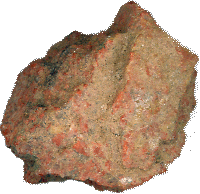Flatlanders hike to the bottom of the Grand Canyon and back; lessons they learned, sometimes the hard way.
Before you go
- Initial scouting visit (would have been nice, didn't do it)
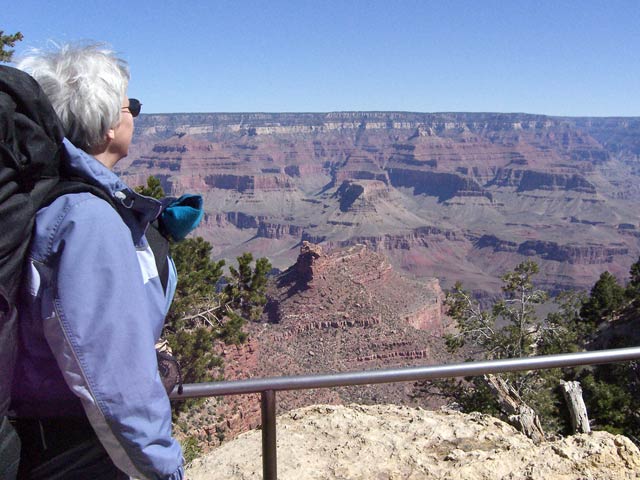

Our first look at the Canyon, near Bright Angel trailhead.If you can, take a short visit to the park before you plan a big trip. You'll get a much better understanding of your lodging choices. Some lodges and cabins have great views but most do not. Knowing what to ask for would be very helpful.
I chose El Tovar based on what I saw on the web, was disappointed and we moved to a Bright Angel cabin after two days.
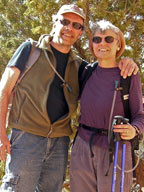

Our short hike on the South Kaibab gave us a taste of what we were in for...so far, so good.Take a day hike down South Kaibab or Bright Angel to get a taste of what you're getting into. Both trails have steep switchbacks early on, so you'll get a sense of how demanding hiking the Canyon is for you.Our first hike was three miles round trip. If you're thinking about hiking with young children a short hike or two will help you decide if they are up for a full-fledged Canyon hiking trip.
- Books, websites
- Hiking Grand Canyon National Park, 2nd (Regional Hiking Series)
I bought this book ($15) in a hotel gift shop. Not bad as an overall introduction, but too big and bulky to be useful while hiking. Pretty good maps.
- Hikernut's Grand Canyon Companion - A Guide to Hiking and Backpacking the Most Popular Trails Into the Canyon: Bright Angel, South Kaibab & North Kaibab Trails
Size-wise same as above, but cheaper and with nearly-unanimous 5-star reviews at Amazon.com, I'd take a look at this book.
- I'd also consider the pocket-sized Hiking the Grand Canyon: A Sierra Club Totebook
, although Amazon reviewers give it only 4 out of 5 stars.
- On the web, start with the U.S. Park Service Grand Canyon National Park - Backcountry Hiking site. Lots of good info, especially Hiking FAQ.
- I also like Hit the Trail, a very comprehensive, useful site.
- Reservations - lodging
- The lodges, campgrounds and especially Phantom Ranch are in great demand and fill up quickly. Try to reserve your spot a year in advance.
- Don't give up. I just tried booking a room online for a year from today and the first page said rooms were not available at any of the hotels and lodges. When I tried the same search at individual lodges I WAS able to find rooms.
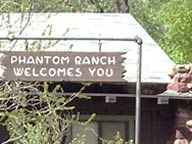
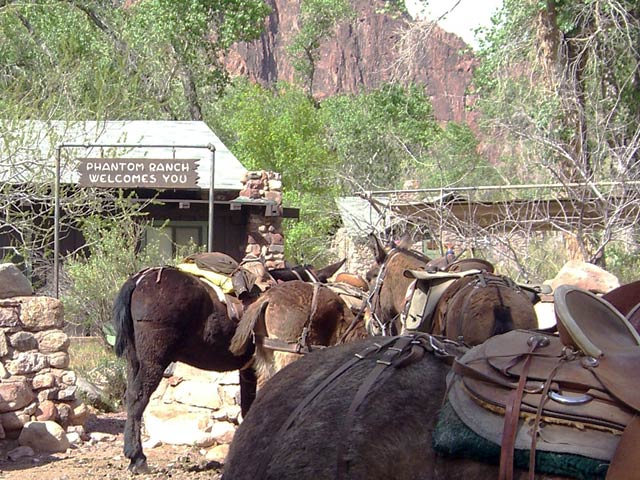
Mule Train passengers get small cabins at Phantom Ranch, not dorms like hikers.Phantom Ranch reservations have a different online application page. If you can't get advance reservations it's still not hopeless. We learned about the "waitlist" that you can sign up for at the Bright Angel Lodge Transportation Desk. No one told us about this when we called for reservations, and it wasn't mentioned by the websites I visited. So here's the deal:
The secret waitlist: In the lobby of the Bright Angel Lodge, just inside the door, is a desk where you can make reservations for Mule Train rides. Also—no one ever told us this, I overheard it in a conversation—if you want to visit Phantom Ranch but don't have a reservation, you can sign up on a waitlist for spaces that may come available.
The desk opens at 5 a.m.—plan to be there promptly at 5 the day before you hope to go to Phantom Ranch. Once you're on the waitlist (I was #1) you have to come back the next day at 6:30 a.m. when they call the names. I was able to get space in the dorms for a male and a female. The next guy on the list was told there was only one male space left. So that day there were a total of three spaces available. I asked several workers what the odds were of getting something and the only answer I got was "every day someone gets something." So...be there at 5 a.m. to get on the top of the list.
You also need to reserve your meals—supper, breakfast and box lunch for the hike back if you want—at the same time.
- Reservations - travel
- A couple months in advance should be enough for both air and rail tickets. I first booked a flight using the Continental website. Later, due to a bone-headed date mixup Expedia came in handy for booking our flight home at the last minute.
- Like airlines, Amtrak has different price levels that go up as the trains get more full. If you're going to several cities on your trip, check into an Amtrak rail pass for 15, 30 or 45 days. It's a great deal if you plan multiple stops.
- Training (see also Can I Do It? below)
- It's a tough hike, so more is better, even if you're already in pretty good shape.
- I found advice at HitTheTrail.com very helpful. Didn't try the trampoline, though.
- We never got around to training with backpacks on, and fortunately we didn't need to pack in tents, sleeping bags, etc. If you plan to camp at the Canyon you'll be carrying much more than we did, so be sure to make it part of your training.
- Equipment - camping, packs, water containers, etc.
- We emailed all our friends, told them about our upcoming trip and were able to borrow packs, sleeping bags, therma-rest pads, etc. (which we never used).
- Carrying lots of water is important (critical in hot weather). We borrowed two Platypus Hoser plastic bladders with tubes & bite valves (we call them sucky hoses). We also carried plain 1 liter plastic water bottles and refilled frequently.
- You can get equipment at the Canyon: rent tents, sleeping bags, etc. at the Canyon Village General Store. A tent, sleeping bags and foam pads for two nights it would cost about $130. Much cheaper to borrow from friends.
- Boots & socks
- If you don't have study hiking boots, buy them a couple of months in advance. You need weeks to break them in properly.
- We spent a lot of time with the sales guy at The Backpacker's Shop near Cleveland, and he was very helpful in finding the best choice for each of us. We may have paid more, but got much better advice than you'd get at a Dick's Sporting Goods, etc.
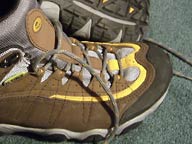

The $120 I invested on the Oboz boots proved worthwhile on the Canyon trails.I ended up with Oboz boots, Joanne got Merrill. Mine feel almost too snug when walking on level paths in the city, but were great on the steep, rocky trails of the Canyon. Very sturdy, very stable on uneven surfaces.
- I love SmartWool socks. They're expensive but very comfortable. They also come in a huge range of styles (are hiking socks "Performance" or "Lifestyle" socks?). I usually wear medium weight hikers but since my boots were snug I switched to lightweight hikers.
- Clothing


It was about 40 degrees on Thursday morning. We have all of our layers on. Temperatures at the Canyon can vary widely, especially in Spring and Fall. We had days when it dropped to the teens and snowed, but our first day was in the mid-60s and sunny.- Plan to wear layers. I usually wore a t-shirt, long-sleeve flannel shirt, fleece vest and North Face rain jacket. On the coldest days I added a wool sweater. When the temperature climbed I took off one or more layers.
- I brought five sets of socks and underwear, two shirts and pairs of pants, and a pair of running shoes to wear after hiking. We did laundry once, at the Mather campground.
- Walking sticks
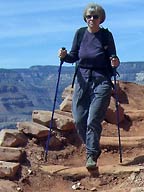

Joanne found the poles especially helpful on the way down.It's common in Europe to see people hiking with the help of two sticks/poles. Not as common in the U.S., maybe it's a macho thing. One or two poles help you keep your balance and take a load off your knees when stepping up or down.I didn't bother with a pole on the hike down into the Canyon but was very happy to use one I'd brought in my pack for the trip up. Here's a good explanation of why and how to use them.
- As you'd expect, poles can cost anywhere from $20 to $80 or more. I bought a pair for $20 each at Dick's Sporting Goods and they were fine. Not sure about long-term durability, since you usually get what you pay for.
- A plain wooden stick works as well as a fancy metal telescoping pole, but doesn't collapse to fit into a pack or suitcase.
Concerns
- Fear of heights
- I'd heard (read?) that the trail was narrow and close the the edge in spots and wondered if it might be kind of scarey. Not sure how it would affect someone with a real fear of heights, but for us it was a non-issue.
- The popular trails (South Kaibab, Bright Angel, Hermit's Rest) are 6-10 feet wide in most places, and never get narrower than about 3 feet. The drop-off is very steep at times, but not always.
- Because the trails are rocky and/or uneven, most of the time you have to keep your eyes on the trail ahead. I didn't have much time to look over the side—in fact I forced myself to stop once in a while to just look around and enjoy the view.
- Can I do it? (physical fitness)
- We saw people of all ages on the trail, from kids as young as 8-9 to folks older than us. Most, but not all, looked relatively fit, very few were significantly obese.
- We were in pretty good shape already: Joanne does yoga regularly and I walk and/or run 10-15 miles a week. We also did a couple of weeks of frequent running up and down stairs inside our house.
- If you enjoy brisk walks in the park for a couple of hours, I think you can probably hike the Canyon. It may take longer and you may be more exhausted and sore than we were, but it doesn't require super-human fitness.
- Unless you're in great shape, don't do it during the summer (June-August). The heat makes everything much harder.
Getting there
- Fly
- We met a number of people who'd flown into Las Vegas, then rented a car to drive to the Grand Canyon. Most stopped at Zion National Park (and loved it).
- Phoenix is about a 2-hour drive and is served by many airlines. We flew out of here to go home.
- Drive
- Obviously you can arrange your own fly/drive or train/drive combination. When we left the Canyon we took a Open Road shuttle to Flagstaff, picked up a rental car, and drove to Joanne's brother's house south of Tucson.
- I did a little checking online and got a much better rental rate from Budget Rent a Car using Expedia than at the official Budget website. Go figure. Also, to my surprise rates at the Budget office at the airport were much cheaper than the one in downtown Flagstaff. We paid about $100 for three days, picking up in Flagstaff and returning in Phoenix.
- Amtrak
- Schedule: most cities in the U.S. have only one or two trains per day, so your choice may be limited. You can book your trip online, on the phone using a pretty good robotic agent, or my preference, by going to the station and talking with an actual person. Two of the three agents I've dealt with in Cleveland have been very helpful. The third, unfortunately, was totally incompetent.
- Rail Pass: a good deal if you're going to multiple places over a period of two or more weeks. Since all Amtrak trains are reserved seating, even with a pass you need to book your entire trip in advance. You can always call and change times, dates, and locations during the trip if necessary.
- On the train/seating: Some conductors assign you a specific seat, others just tell you what car to sit in. If you have a choice, I'd avoid seats near the ends of the car (noise from doors opening and closing all day and night). If it's a two-level Superliner the seats in the exact middle of the car face the stairs to the lower level and there's the same traffic issue. If there are empty seats you can usually move, but be sure to take the paper destination tag above your seat with you.
- On the train/eating: The dining car has decent food but will run you $10-25 depending on the meal. I like to eat breakfast in the diner and usually bring my own lunch and supper. If you have a couple hour layover in Chicago or another city, stock up on fruit, sandwiches, drinks, etc. The Sightseer Lounge Car is a great place to eat and watch the miles roll by.
- Side trips
- If you have time, there are lots of parks and other attractions near the Grand Canyon. Spend some time with a map before you finalize your itinerary.
- Obviously a rental car gives you the most flexibility, but there are various bus tours that you can do as well.
At the Canyon
- Where to stay
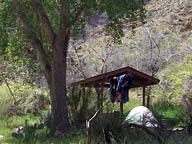

Indian Garden campsites are large and shady.CampingWe considered hiking to Indian Garden campground (4.6 miles from the rim on the Bright Angel Trail) but snow, cold and wind changed our minds.
To get a campsite you can fax a request no more than four months before your visit, or go in person to the Backcountry Information Center at Grand Canyon Village.
You can also get on a waitlist for a next-day permit. We stopped in at noon one day and were #12 on the list. All of these options are described in detail on the Backcountry Permit page.
Mather campground at the South Rim itself accepts reservations up to five months in advance. More information.
- Hotel/lodge
Your choices range from the historic (El Tovar, Bright Angel) to modern (Thunderbird, Kachina, Maswick, Yavapai). Bright Angel has cabins and dorms as well as the lodge itself. The El Tovar, Kachina, and Thunderbird are very close to the rim, but your room may not have a view, since half face the Canyon and half the other way. Some of the Bright Angel cabins are quite close to the rim, others are closer to a parking lot and roadway (like ours).
Xanterra runs all Grand Canyon lodging and you'll find lots of info on their website. But it's hard to absorb all this without actually seeing it, hence my earlier recommendation that you try for a quick scouting visit to the Canyon in advance.
We stayed at the El Tovar for two days ($174/night) and it wasn't worth it. Our first-floor room was small—not a problem—but faced the dining room patio so there were people literally right outside our window. When I asked for a different room the front desk staff was decidedly unhelpful.
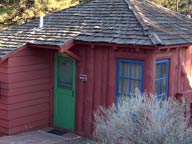

Our spacious-but-not-secluded cabinAfter two nights we moved to a cheaper 88($111/night), larger Bright Angel cabin. Our location issues followed us: every window in the cabin faced either another cabin, a sidewalk, or a road. So much for privacy. Still, the cabin was a big improvement over the El Tovar.
- Where to eat
- El Tovar: expensive, interesting food in a historic dining room with great canyon views. We had breakfast there once. Food was good but not great, service was adequate at best. If your budget permits, I suggest going once for a fancy dinner celebration, otherwise there are better choices.
- Bright Angel: moderate prices, good food, excellent service. We ate here several times, breakfast and dinner, and liked it a lot. In my opinion the best place to eat at the Canyon.
- Maswick: cafeteria style dining with lots of menu choices. Prices are the lowest of the places we visited, but not what I'd call cheap. Food quality was just average. If you're on a budget and/or are with kids, might be your best choice.
- General store: there's a well-stocked market at the Canyon Village. Choose from a wide selection of fruit, veggies, and groceries. You'll also find prepared food like sandwiches, salads, etc. Stock up here and eat in your room or cabin.
The hikes themselves
- Strategy

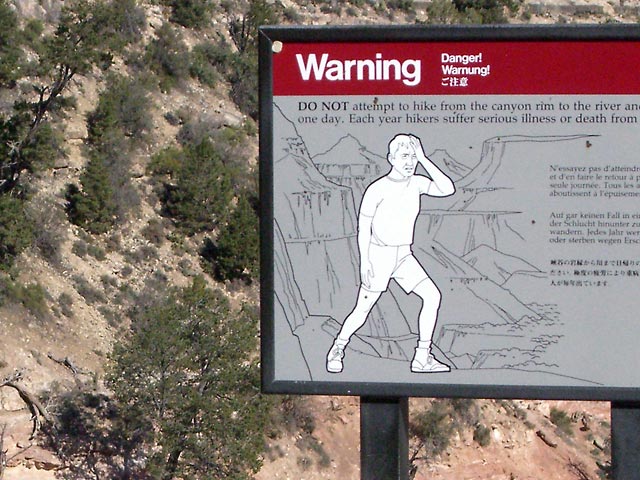
If you don't get this message you are seriously ignorantThe warnings are everywhere: "Don't attempt to hike down to the river and back in one day."
So, how many days do you need? At least two: hike down on the first day, stay overnight at Bright Angel Campground or Phantom Ranch, and hike out the next day. If you have more time, another day or two at the bottom will give you time for rest, recuperation and/or more hiking.
An alternative that we planned in case we couldn't get reservations at Phantom Ranch is to hike to Indian Garden on Day 1, stay overnight, hike to the bottom and back to Indian Garden on Day 2, stay overnight and hike back out on Day 3. If you enjoy camping this is a good choice.
- Guidebooks, maps
I've discussed this above, but would like to add that the main trails—Bright Angel, Kaibab, etc.—are so obvious and well-marked that you don't need a map or guidebook. A pocket-size guide is worth having, like the Trail Guides put out by the Grand Canyon Association. They're about $3 each and easy to carry in your pocket.
- Clothes, layering
Keep in mind that the weather can change quickly, and it's often 20 degrees warmer at the bottom of the Canyon. Multiple layers let you adjust for whatever Mother Nature throws at you. One layer should be raingear just in case. FYI: monsoon season is mid-July to early September.
At one point or another I wore every layer I'd brought except a thermal T-shirt.
- Oh, the sun
You'll be outside a long time, 6-8 hours. Be sure to bring and use sunscreen, sunglasses and a hat even if it's cloudy. You don't want to add sunburn pain to your aching muscles at the end of the day.
- Walking sticks
Not essential but very helpful. I'd say less than half the hikers we saw used them, but I was very glad I did on the way up. If you have knee/ankle/balance issues, absolutely use them. I also appreciated the extra security they offered as I got tired.
- Water & food
We took a half-dozen power bars each, along with a couple of apples and oranges. We also had some cheese, bagels, and trail mix. This turned out to be more than enough, especially on Day 2 when we bought box lunches at Phantom Ranch. We finished our hike with nearly as much food as we'd started with!
Because the weather was cool we didn't need nearly as much water as you would on hot summer days. We each carried one or two 1-liter water bottles, plus another liter or two each in Platypus bladders in our packs. We drank less than 3 liters each during our 6-7 hour hikes.
For summer hiking it's recommended that you drink 1/2 to one liter per hour, and I'm sure that more is better. More good advice on summer hiking.
- Day hikes
The two short hikes we did on Monday and Tuesday were good preparation for our hike to the river on Thursday. Having a day off (Wednesday when it was cold and snowy) was nice too. We started gradually with a 3-mile roundtrip to Cedar Ridge on South Kaibab, then did about 5 miles the next day on the Hermit's Rest trail.
- To the Colorado and back
We hiked down via Bright Angel Trail and back the next day on the South Kaibab, the opposite of what most hikers do. Many people think it's easier to take the shorter, steeper Kaibab down and use the longer but less steep Bright Angel to go back.
We preferred the opposite because Joanne's bum knee makes hiking downhill harder. It was much better to have the steep climb on the uphill. We made it back to the rim in 6.5 hours even after an hour lunch break at Cedar Ridge.

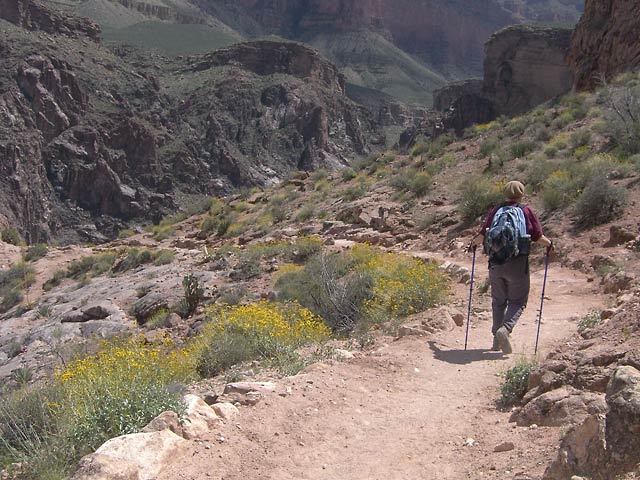
From Indian Garden to the Colorado the trail generally follows a stream. Another advantage to hiking down via Bright Angel is that on second part of the hike, from Indian Garden to the river, you're alongside a stream for most of the way. Very pretty, especially welcome when you're hot and tired. The last mile you're looking down at the Colorado River. And it's true: that last mile seems a lot longer than you expect.In the heat of summer the problem with using the South Kaibab to hike out is that there is no water available along the way, so you need to carry more. Bright Angel has water year-round at Indian Garden, and in the summer at two other locations. Plan accordingly.
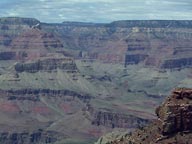
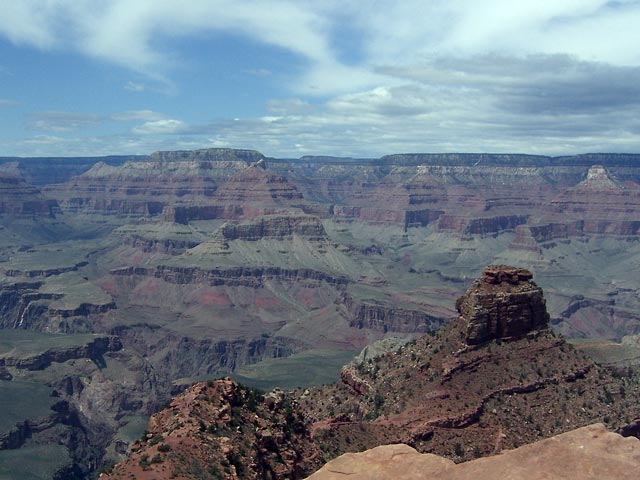
The South Kaibab follows ridgelines, giving you lots of great views.To sum up: our hikes both ways were great. Bright Angel was prettier along the stream and river, but Kaibab had more spectacular canyon views.No matter which route you take I urge you to get down into the Canyon. It made the whole trip worthwhile for me. The views from the Rim are fine, but inside the Canyon you get a whole different appreciate for the place. You also learn about yourself, how much you can accomplish by just moving forward. From the bottom the canyon rim looks impossibly high and distant. But 6 or 7 or 8 hours later you're there. You did it, and it feels great.
- Phantom Ranch
At the bottom of the Canyon you can either stay at the Bright Angel Campground or Phantom Ranch. You reach both by crossing one of two suspension bridges, either the Silver Bridge (Bright Angel Trail) or the Black Bridge (S. Kaibab). Both are beautiful, impressive feats of engineering, and are a welcome sight at the end of a long day.
We were getting tired and cranky when we passed the campground, so were happy that Phantom Ranch wasn't far away. We got there around 4 and headed immediately to the canteen to sign in and buy big glasses of lemonade.
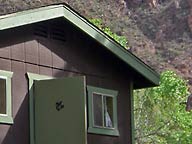
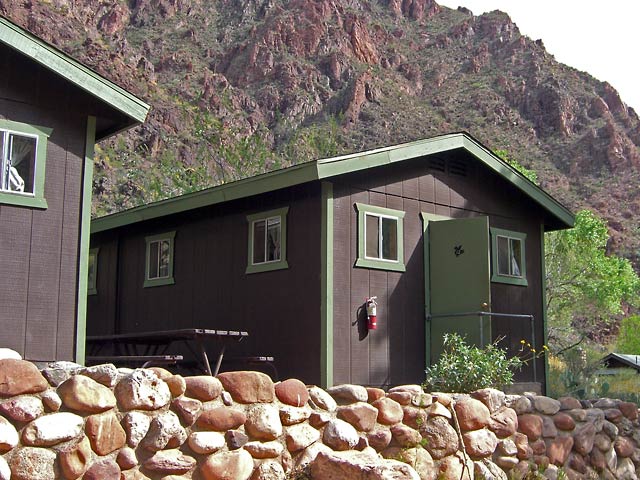
My deluxe accommodation at Phantom RanchAs late-comers, both Joanne and I ended up with top bunks in the small cabins they call dorms. Each dorm has five bunk beds, a small shower and a toilet. The Ritz it ain't. Still, mostly what you need at this point is a place to throw your pack and a bed to sleep in. That's exactly what you get.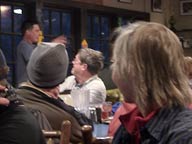
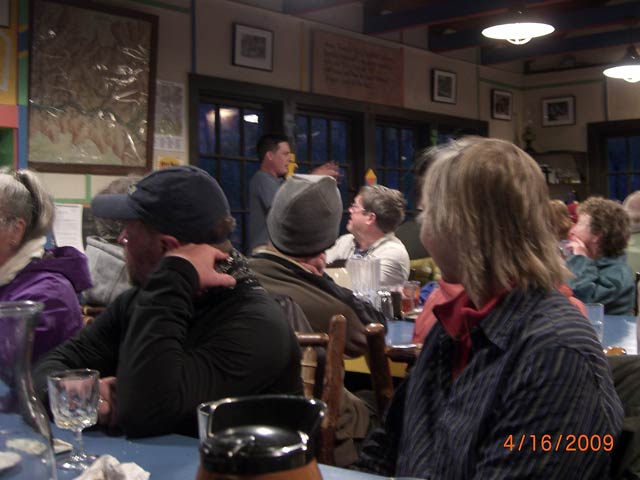
After dinner the friendly staff person answered all our questions about Phantom Ranch.Meals are served family-style at the canteen. The food is plentiful and good, and people are universally friendly and talkative. We met a woman from Colorado who visits Cleveland every three years for a conference, and made plans to go to an orchestra concert when she's here in December. - Sun
protection
You'll be outside a long time, 6-8 hours. Be sure to bring and use sunscreen, sunglasses and a hat even if it's cloudy. You don't want to add sunburn pain to your aching muscles at the end of the day.
-
Medication
Of course, bring any medication you need to take daily if you'll be on the trail for a couple of days. And bring plenty of your painkiller of choice (Tylenol, aspirin, ibuprofin, etc.) just in case.
-
Phone, iPod
Leave 'em. Your phone probably won't work inside the canyon walls (mine didn't), and why would you even consider listening to music when you're walking in one of the world's most spectacular places?
